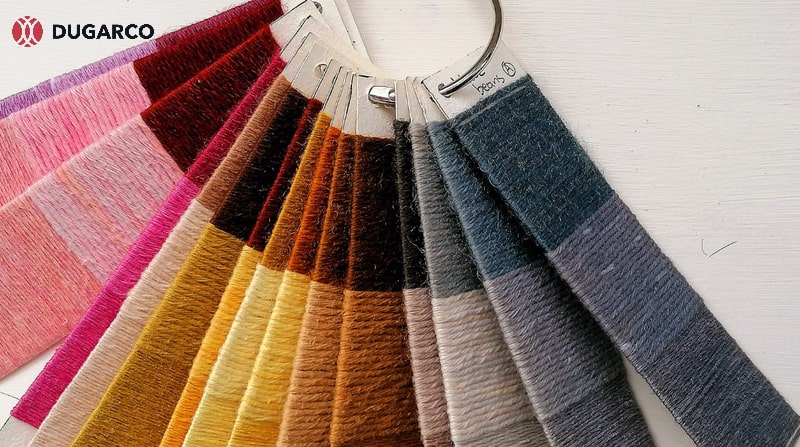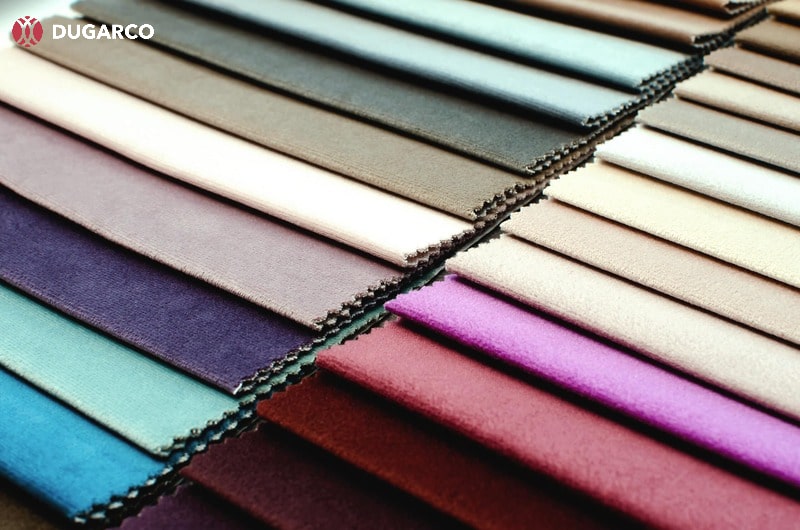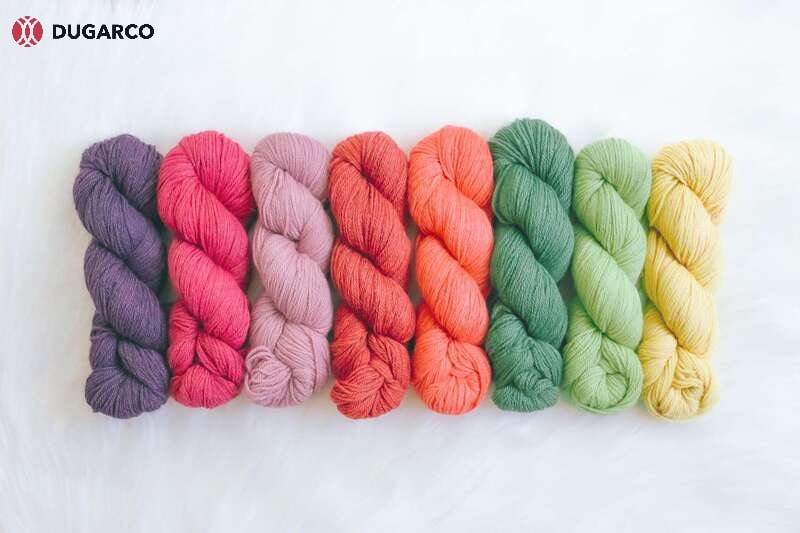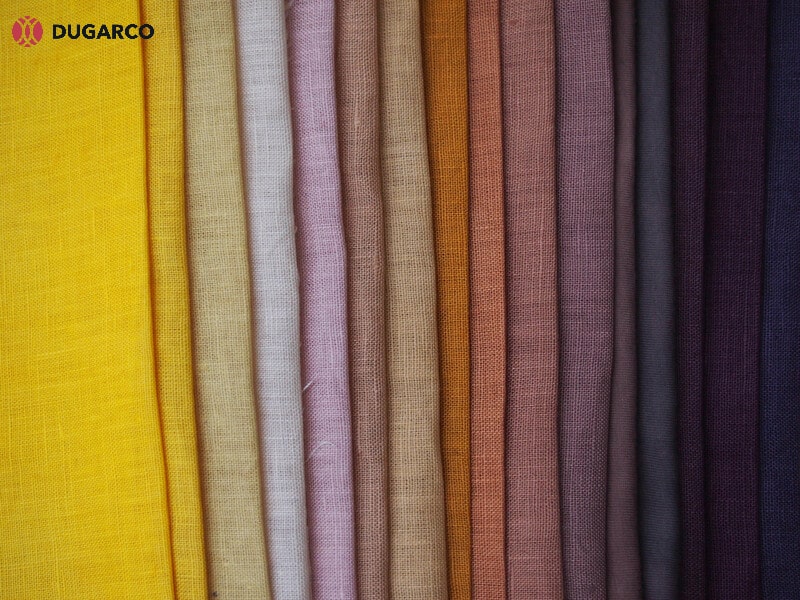Colorfastness is a very common term in the textile industry, thanks to it people will judge the quality and durability of the product. So what is color fastness, how important is it and how many testing methods are there? Let’s find out with Dugarco!
1. What is color fastness meaning?
Color fastness is a term, that characterizes the ability of a material to resist fading or fading. This is one of the essential indicators to measure product quality. The colorfastness is proportional to the bonding force between the photoelectric dye and the fiber. It can also be influenced by handling techniques and the choice of chemicals and detergents.

The big challenge with all kinds of clothes is that the dye in the washing process fades when it is exposed to light or rubbed during the washing and drying process. Colorfastness is a very important factor in the quality of the product. Therefore, you should test the colorfastness of your clothes before using any bleach or bleach solution or detergent.
>>>> CLICK NOW: Making natural fabric dyes | A complete detailed guide
2. Important terms and definitions of color fastness
Here are 5 important terms that you need to keep in mind when it comes to color fastness:
- Colorfastness: The ability of a color to resist external influences, differentiated between fastness to manufacture and fastness to use.
- Color change: The color change in the spectrum between the treated and untreated samples in the tests. Color variation can be caused by changes in color tint as well as color purity.
- Bleeding: This is a term that describes the difference in color between an undyed, untreated control fabric and a similar but treated fabric sample. This difference is the result of dye migration from the treated fabric to the control fabric.
- Grayscale: A standard color scale that evaluates color change by comparing the contrast between the control fabric and the treated fabric. The grayscale used to assess color variation consists of five pairs of standardized, matte, gray palettes with varying contrasts.
- Blue scale: A special scale used to evaluate light fastness. It includes eight standard palettes sorted by their lightfastness. In addition, this method is also used to evaluate the washing fastness and sweat resistance of fabrics.

3. What factors affect colorfastness?
So what causes the dye fastness of some fabrics to be reduced? Here are some common causes that affect it:
- Each yarn has a different property, and each type of fabric has different color adhesion, natural fabrics will have a lower dyeing ability than synthetic fabrics. Such as the color polyester yarn is often more durable than nylon.
- Light-toned colors tend to last longer than dark-toned colors.
- Structure and characteristics of fabric dyes used.
- Fabric properties.
- Any fabric pretreatment was used.

- Fabric dyeing technique is also a factor affecting the fastness of fabric colors, it will determine whether the finished product will have high or low colorfastness. The person performing the dyeing must know how to properly mix the dye, use the right chemicals, and follow the correct dyeing process.
- Any damage to the used fabric surface.
- After dyeing, is the fabric treated with soap?
- The way a dyed fabric is finished and fixed.
>>>> CLICK HERE: Grams per square meter fabric definition and application
4. Different types of color fastness test methods
The phenomenon of fading of fabrics when washing daily is inevitable. Color fastness explains the resistance to physical and chemical effects during dyeing and the use of textile colors. The setting of the colorfastness level is the basis for assessing the quality of the fabric. Join us to learn the methods of testing fabric colorfastness under various conditions. Here are 7 popular methods:
4.1. Colorfastness to light
This is a test method based on the color change of colored fabrics when exposed to light. The method is quite simple, expose the color sample to sunlight or a sunlight machine, and then compare the color fading of the exposed sample and the standard sample. The color fastness rating standard is divided into 8 levels, of which level 8 is the level with the best colorfastness.

In addition, the most common international standards for colorfastness to light are ISO 105 B02 and AATCC 16. Both of these standards test the color of fabrics under a Xenon Arc lamp which closely resembles natural sunlight. The requirements in these two standards differ significantly in the method of assessment.
4.2. Color fastness to washing
Washing fastness is an assessment of the color change of fabric after washing and exposure to soap. This is one of the major concerns of textile importers. A good and washable textile product means it can withstand repeated washing without losing its color properties or staining other products washed with it.

The two main standards of the dye fastness test method for washing with bleach to determine the fastness of textile colors are ISO 105 C06 and AATCC 61. There are 16 test procedures in ISO 105 C06, from A1S to E2S. For the AATCC 61 standard, there are five test procedures, but 1A and 2A are the most common test procedures.
4.3. Color fastness to perspiration
Fabric dyes and human perspiration can often react with each other and cause color fading. The colorfastness test for sweat is great for sportswear and swimwear lines. These are clothes that are likely to be exposed to a lot of sweat during use.

ISO 105 E04 and AATCC 15 are the two standards for endurance testing with this method. The laboratory attaches a strip of various multi-filament fabrics to the specimen, such as nylon, cotton, acetate, polyester, wool, and acrylic to measure colorfastness. Then a gray scale will be used to compare the staining with the multifilament fabric. ISO 105 E04 tests colorfastness to acidic and alkaline perspiration, while AATCC 15 tests only acid perspiration.
4.4. Colorfastness to rubbing
Colorfastness to rubbing is a test method through color loss after rubbing colored fabrics. There are two types of friction: dry friction and wet friction. The assessment of fabric color fastness by this method is derived from a comparison of white fabric with a gray card rating. The test results in this method are generally divided into 5 levels, the larger the rating value, the higher the friction colorfastness.

4.5. Color fastness to water
Colorfastness to water is a method to test the water resistance of textiles. ISO 105 E01 and AATCC 107 are the two most popular standards for testing fabric colorfastness with this method. In addition, for this method, there are two common types of tests: color fastness to seawater and colorfastness to chlorinated water.

For both seawater and chlorinated water, lab technicians attach a strip of multifilament fabric samples and let them soak together in the two different waters at specific time and temperature conditions. This is to measure the staining of the fabric. When soaked for the required time, the fabric is placed between glass or plastic plates and dried under the specified time and temperature conditions. The multifilament fabric is then compared with the Gray Scale for dyeing. With that, the test sample is compared with the Gray Scale for color change.
4.6. Color fastness to hot pressing
This method is concerned with the degree of sublimation of colored fabrics during storage. The color fastness of the fabric when hot pressing will be rated based on taking the gray grading sample card as the standard and divided into 5 levels. The higher the level, the better the colorfastness of the fabric. This method is evaluated by observing the discoloration, fading, and staining of white fabrics and is generally applied to polyester fabrics.

4.7. Color fastness to crocking
The crocking test determines color fastness through a textile’s ability to resist rubbing and staining of other materials. Fabric colors with poor fastness will lose colorant on consumers, furniture, other textiles, or miscellaneous items. ISO 105 X12 and AATCC 8 are two common standards in testing using this method. According to these standards, durability is divided into two categories: dry frictional strength and wet resistance.

Test samples are rubbed with a dry cloth and then a wet cloth, and then a machine called a “crock meter” is used to rub the fabric in separate vertical and horizontal directions. Fabric colorfastness will be assessed using the Gray Scale for staining, rating level 4 for dry rubbing, and grade 3 for wet rubbing. For most fabrics, colorfastness to wet rubbing is generally lower than to dry rubbing.
5. Popular fastness ratings
Since there are many factors affecting the colorfastness of fabrics, the international metrology organizations for textiles have taken care of, classified, defined, and standardized different types of colorfastness into a system convenient for testing and evaluating the colorfastness of textile product manufacturers before the finished product is shipped. The color fastness rankings are in the following order:
- Very poor
- Poor
- Average
- Better
- Best/Excellent

6. How to improve colour fastness?
Some ways to improve color fastness can refer:
- Some fabric colors are not as durable as you would like. To improve this situation, you can use a color fixative during the dyeing process to improve the fastness of the color.
- Colorfastness also depends on the color of the fabric, so when choosing a fabric color, you need to pay attention to the purpose and circumstances of use to choose the right color. For example, light colors will fade faster than dark colors under strong light. Neon, light, and dark colors will stain more easily than light colors.
- For fabrics made from regular polyester, by changing the yarn to cationic polyester, we can improve its colorfastness.
- In addition, manufacturers need to carefully consider and compromise designs to achieve the standard of colorfastness they expect.

7. Importance of color fastness
Here are some color fastness meaning that you should know:
- Consumers can judge products based on the durability of fabric colors. If the product color has good fastness, the fabric quality is high and vice versa, if the product color has poor colorfastness, the fabric quality is poor.
- The colorfastness of fabrics is one of the most important. It will determine the performance and evaluate the product to determine if the material is fit for the intended use. It is an identity for the fabric.
- Whether the color of the fabric is durable or not is an important factor for buyers to distinguish which fabric is bad, and which fabric is good.
- In addition, color also affects the fashion and aesthetics of clothing, it is responsible for enhancing product value for both the user and the brand.
- Color is durable or not is also one of the most important characteristics in attracting customers.

8. Chemical risks in color dyeing process
Prohibited or restricted chemicals are likely to remain in the fabric during textile dyeing and post-washing treatment. This can be improved if the manufacturing and handling process is good. In addition, you should assess the chemical risk of your materials as well as the color fastness of the final product, which is one of the essential pieces of information from your supply chain.

Colorfastness represents the life of the product as well as the dye quality of the garment. The above article is information about color fastness, its importance, influencing factors as well and how to check. Hope the article can help you gain more useful knowledge about it and become a smart consumer. Contact Dugarco immediately if you need any questions answered!
Contact information:
- Address: 59 Đức Giang, Đức Giang, Long Biên, HN
- Phone: 024 3655 7930
- Email: dugarco@mayducgiang.com.vn
- Website: https://dugarco.com/en/
>>>> RELATED POSTS:
- 4+ important raw materials for garment manufacturing
- Quality control clothing – The importance and procedures

Dugarco under the talented leadership and guidance of Mr. Hoang Ve Dung has gradually become a large Vietnam clothing manufacturer, supplying clothes for many famous brands from many different countries such as the UK, USA, and Australia.





